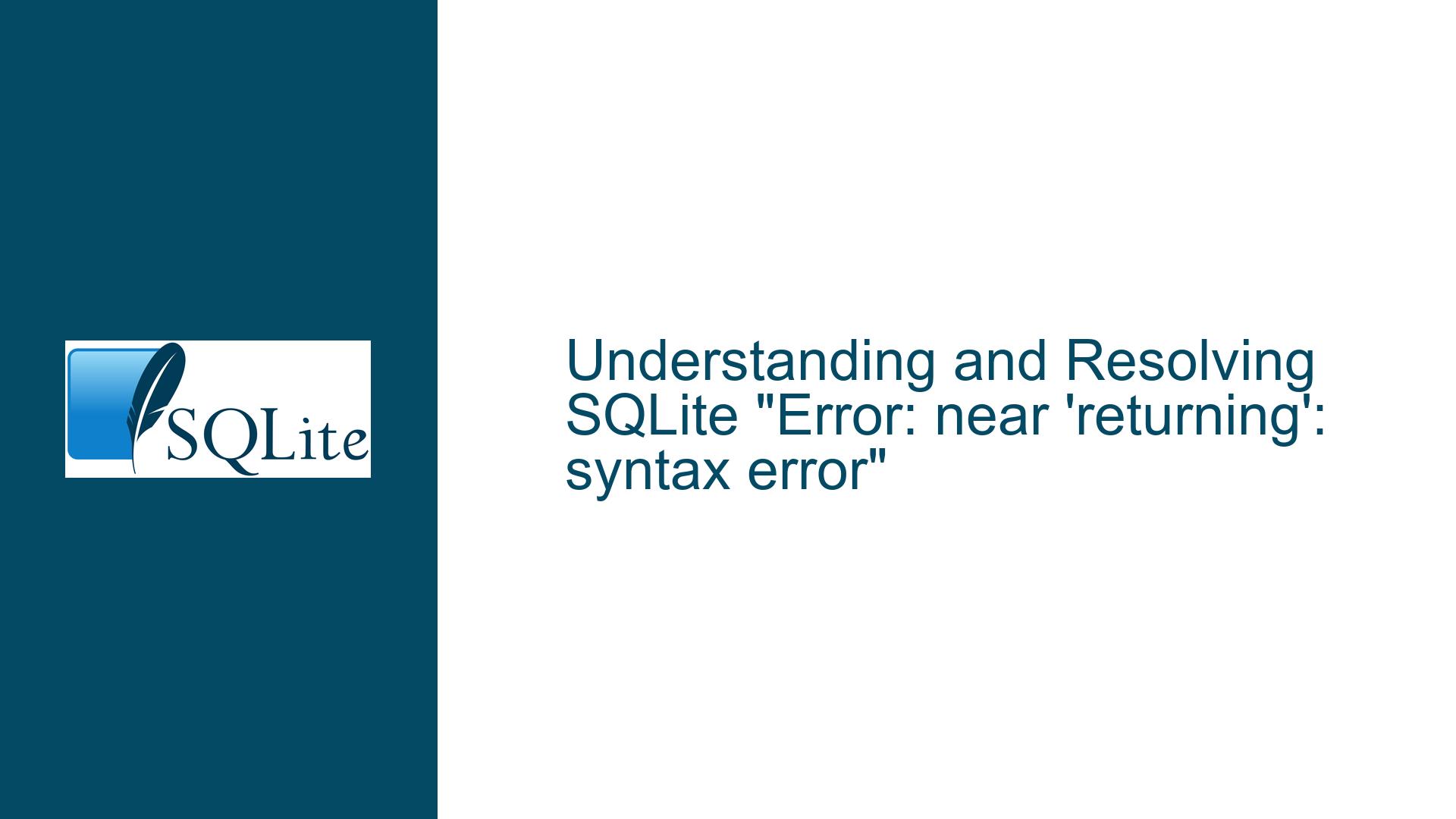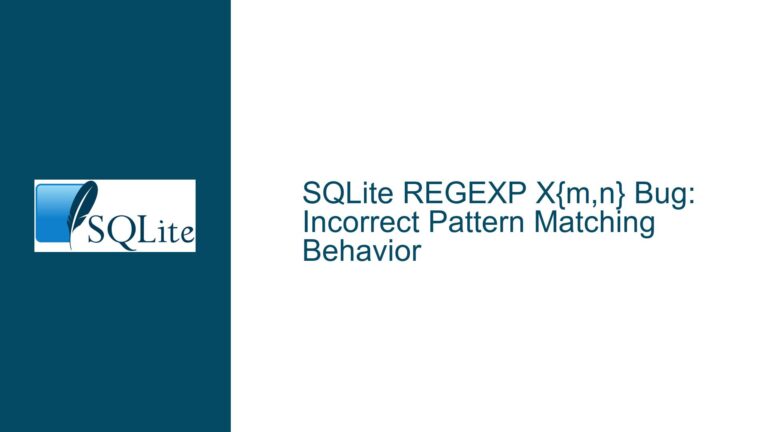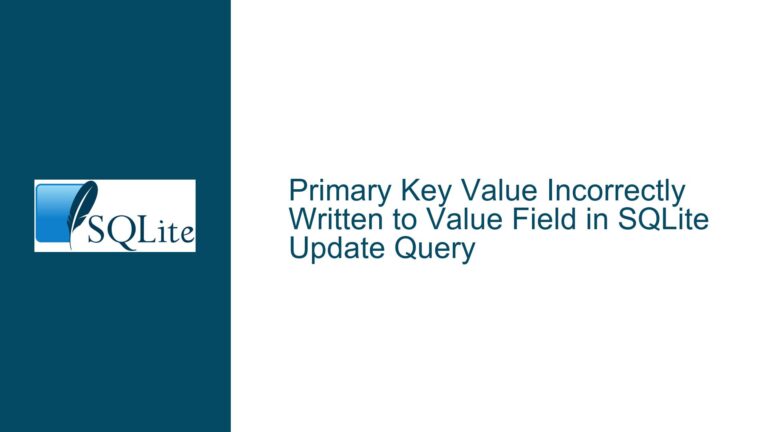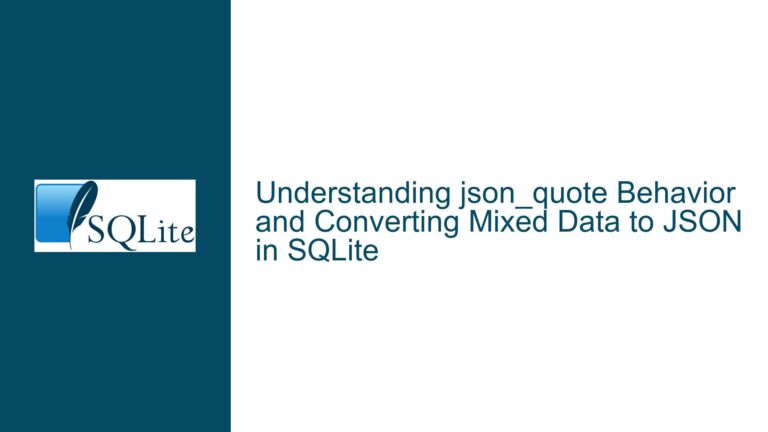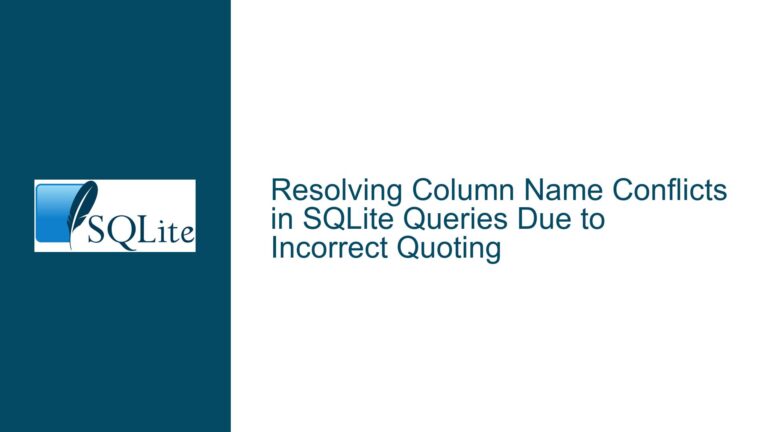and Resolving SQLite “Error: near ‘returning’: syntax error”
SQLite RETURNING Clause Syntax Error in Older Versions
The SQLite database engine is renowned for its lightweight, serverless architecture and robust feature set. However, as with any software, certain features are introduced in specific versions, and attempting to use these features in older versions can lead to syntax errors. One such feature is the RETURNING clause, which was introduced in SQLite version 3.35.0. This clause allows users to retrieve the values of inserted, updated, or deleted rows directly within the same SQL statement. When attempting to use the RETURNING clause in versions prior to 3.35.0, users encounter the error: Error: near "returning": syntax error.
The RETURNING clause is particularly useful in scenarios where you need to immediately access the values of the rows affected by an INSERT, UPDATE, or DELETE operation. For example, when inserting a new row into a table with an auto-incrementing primary key, the RETURNING clause can be used to fetch the newly generated key without requiring a separate SELECT statement. This can simplify code and improve performance by reducing the number of database round-trips.
However, the absence of this feature in older versions of SQLite can lead to confusion and errors, especially for developers who are unaware of the version-specific nature of certain SQLite features. The error message itself, Error: near "returning": syntax error, is SQLite’s way of indicating that it does not recognize the RETURNING clause as valid syntax. This is because the SQLite parser in versions prior to 3.35.0 does not include the RETURNING clause in its grammar rules.
Version-Specific Feature Support in SQLite
The core issue here stems from the fact that SQLite, like many other software systems, evolves over time. New features are added, bugs are fixed, and performance improvements are made. The RETURNING clause is one such feature that was added to enhance the functionality of SQLite. However, this also means that the feature is not available in versions of SQLite that were released before version 3.35.0.
When a developer attempts to use the RETURNING clause in an older version of SQLite, the SQLite parser encounters a keyword that it does not recognize. The parser is designed to follow a strict set of grammar rules that define the valid syntax for SQL statements. When it encounters a keyword or clause that is not part of its grammar, it raises a syntax error. In this case, the keyword RETURNING is not part of the grammar in versions prior to 3.35.0, leading to the error message.
This issue is further compounded by the fact that SQLite is often embedded within applications, and the version of SQLite used by the application may not be immediately apparent to the developer. This can lead to situations where a developer writes SQL code that works on their local machine (which may have a newer version of SQLite) but fails when deployed to a production environment (which may have an older version of SQLite).
Upgrading SQLite and Ensuring Compatibility
The most straightforward solution to this issue is to upgrade the SQLite library to version 3.35.0 or later. This will ensure that the RETURNING clause is recognized and processed correctly by the SQLite parser. However, upgrading SQLite is not always a trivial task, especially in environments where SQLite is embedded within an application or where the application is distributed to multiple users.
Before upgrading, it is important to verify the current version of SQLite being used. This can be done by executing the following SQL command:
SELECT sqlite_version();
This command will return the version of the SQLite library currently in use. If the version is older than 3.35.0, an upgrade is necessary to use the RETURNING clause.
Once the version has been verified, the next step is to obtain the latest version of SQLite. The official SQLite website provides precompiled binaries for various platforms, as well as the source code for those who prefer to compile SQLite themselves. It is important to ensure that the correct version is downloaded and installed, and that any applications using SQLite are configured to use the new version.
After upgrading, it is crucial to test the application thoroughly to ensure that the upgrade has not introduced any new issues. This includes verifying that all existing SQL statements continue to work as expected, and that the RETURNING clause functions correctly in the context of the application.
In cases where upgrading SQLite is not feasible, an alternative approach is to rewrite the SQL statements to avoid using the RETURNING clause. For example, instead of using the RETURNING clause to retrieve the value of an auto-incrementing primary key after an INSERT operation, you can use the last_insert_rowid() function. This function returns the rowid of the most recently inserted row, which can be used to fetch the newly inserted row using a subsequent SELECT statement.
-- Insert a new row into the test table
INSERT INTO test DEFAULT VALUES;
-- Retrieve the id of the newly inserted row
SELECT id FROM test WHERE rowid = last_insert_rowid();
While this approach requires an additional SELECT statement, it achieves the same result as the RETURNING clause and is compatible with older versions of SQLite.
In conclusion, the Error: near "returning": syntax error is a direct result of attempting to use the RETURNING clause in a version of SQLite that does not support it. The most effective solution is to upgrade to SQLite version 3.35.0 or later. However, if upgrading is not an option, the functionality of the RETURNING clause can be replicated using the last_insert_rowid() function and a subsequent SELECT statement. By understanding the version-specific nature of SQLite features and taking appropriate steps to ensure compatibility, developers can avoid this and similar issues in their applications.
